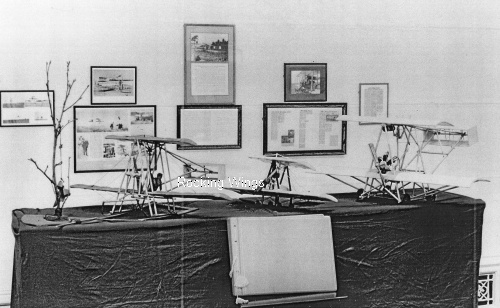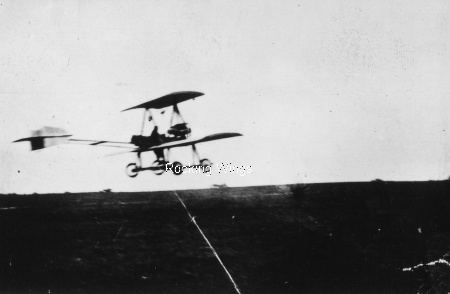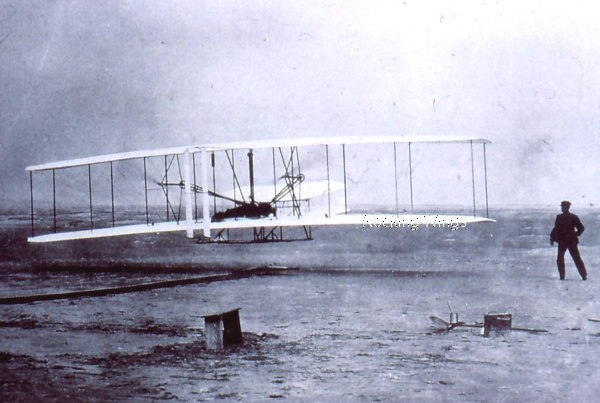Did Preston Watson Fly before the Wright Brothers?

A display of models and photographs celebrating Watson's achievements at the Dundee MacManus Museum. Unfortunately for the viewing public, it is orientated towards James Watson's disproven claims of powered flight before the Wright Brothers. Clem Watson via the RAF Museum
Following James Watson’s interruption of the Royal Aeronautical Society/Royal Aero Club dinner at the Dorchester Hotel in London in December 1953 to prove that his late older brother flew a powered aeroplane before the Wright Brothers in the summer of 1903, Director of the Victoria and Albert Museum and professional aviation researcher Charles Gibbs-Smith vigorously investigated the Watson claim. The presentation of Gibbs-Smith's findings to him eventually forced a change of tack from Watson the Younger.
Published in the December 1955 issue of Aeronautics magazine, James changed his story, stating that “Preston’s first aeroplane was without an engine” and that, “...trial flights were made at Errol in the summer of 1903.” In a letter to Gibbs-Smith, James also wrote, "I make no claim that the 'machine' that Preston used in 1903 at Errol was a powered machine."
This “confession” gave rise to rumours that Preston had built a “Wright Type glider” at that time, although no such claim had appeared before. A so-called reliable source was found in a close friend of the Watson family, former head of Kings College Dental Department, dental surgeon John Bell Milne, who claimed to have seen Preston's earliest flying machine, but had not witnessed it in flight.
In correspondence with Gibbs-Smith, Milne later described the aircraft as, "...definitely a glider, it had skids. It was of normal biplane build, both wings in the same span. It had an elevator out front." In an interview he gave in 1961, Milne remembered that Watson constructed his glider in, "...late 1903 or early 1904", at the time he and Preston, "...were attending physics classes at University College [Dundee]."
What makes the assertion that Preston Watson built a glider, or indeed any aircraft in 1903 questionable is that James Watson publicly contradicts himself on more than one occasion. Only after being pressured by Gibbs-Smith after first making his claims in 1953 did James Watson admit that the aircraft Preston flew in 1903 was a glider. Prior to this admission, there was never any mention of a Watson built glider, neither by James, the eyewitnesses James presented in support of his original claim, nor significantly, by Preston Watson himself.
Read more about the "Wright Type" glider here
At the inquest into Preston's untimely death on 30 June 1915, his father stated that his son, "...had taken a great interest in flying for the past seven years", suggesting that the year in which he was aware that Preston begun his fascination with flight was 1908, the year in which Wilbur Wright first flew in Europe and news of the Wright Brother's exploits became available to the public at large.
Although Watson did apply for a patent for rotary winged flying machines in late 1907 however, had an aircraft been built that incorporated his ideas, with all the will in the world it never would have left the ground. This is another fact that flies in the face of a Watson built flying machine of any sort in 1903. Why would he produce such naïve work if his prior research into methods of achieving flight had been successful?
Another cause for debate is the claim that Preston Watson approached notorious Brazilian aviator Alberto Santos-Dumont in 1906 and purchased a Dutheil Chalmers engine from him. In 1955, John Bell Milne made a personal assertion to Charles Gibbs-Smith that the year the motor was purchased was indeed 1906. This could not have been possible, since Dutheil Chalmers & Cie did not construct their first aero-engine until 1907. In a later interview Milne gave he changed the date to a year later, thus bringing his earlier statements’ validity into question.
Photographs show a Dutheil Chalmers motor fitted to Watson's first rocking wing aircraft, but Gibbs-Smith later presented these to M. Charles Dolfuss, Director of the Musee de L'Air at Le Bourget, Paris who confirmed it as a 1908 or 1909 four cylinder 40 hp Dutheil Chalmers motor. If Watson acquired the Dutheil Chalmers engine from Santos-Dumont, the earliest date the purchase could have taken place was 1908.
A further false statement made by James Watson was that Preston had the No.3 shipped to France and entered into a competition, in which it won a safety award. No evidence of this can be found anywhere. The only competition in France Preston entered any of his aeroplanes in was the Concours de La Sécurité en Aéroplanes, in which his No.3 aeroplane was disqualified. Some sources quote the date in which Watson's No.3 won the safety prize was 1913, but the Concours held between 1 January and 1 July 1914 was the first of its kind.

A blurry image of Watson's No.3 that was once captioned indicating that it had won a diploma for a safety device against side slip in an open competition in 1913. This is completely false. The photograph was taken in 1914 at the Concours de La Sécurité en Aéroplanes competition, at which Watson's aeroplane was disqualified. Philip Jarrett
As with most claims of powered-flight-before-the-Wrights, the only supporting evidence James Watson produced were that of eyewitnesses. Like other claimants, the eyewitness accounts James Watson supplies are inconsistent with one another and were made at least fifty years after the alleged events took place. In this respect the Watson case draws parallels with that of New Zealander Richard Pearse. (Of course, if the Pearse supporters are to be believed, Watson’s flights of 1903 are inconsequential, since Pearse flew long before then!)
Certainly the most colourful recollection is that of Harry Band, a Kirriemuir man who in 1955 at the tender age of 77, reported that Watson’s aeroplane was, "...like a lot o' bloomin' old window blinds and sticks tied together. There was a thing whirlin' on the front of it as far as I could make out, when all at once the thing was up in the air. It would have flown over the top o' an ordinary cottage..."
In a letter dated 19 December 1959 to one G. Bolt Esq., after he had submitted information about Richard Pearse to Charles Gibbs-Smith, the latter advises Bolt to be wary of eyewitness claims. With regards to the Watson case, he states that after the story and photographs were published in 1953;
“…the late J.Y. Watson admitted that his great edifice was false, and this after producing eyewitness to the actual event. The eyewitness who tells you what he saw fifty or more years after is, as often as not, completely unreliable; and this was driven home in the Watson case. People simply do not remember without prejudice.”
None of this has prevented a flood of articles and further reassertions of the discredited James Watson stories in newspapers and magazines since, however. During the 100th anniversary year of the Wright’s first powered flight, a number of Scottish reporters took up the story and published “their” exclusive in the local press, recycling the same quotes and statements between them.
This is unfortunate, considering the work that Preston actually carried out, and the conviction and enthusiasm he had for his subject matter. It is truly lamentable that he isn’t remembered for his pioneering work, regardless of the fact that it has proven to be fruitless.
Search for sources of reference on Preston Watson here
